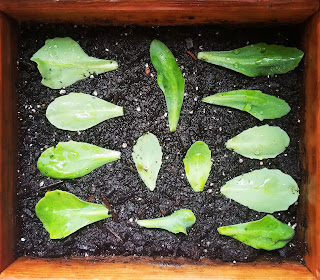Sedum Love (and Propagation)
There’s nothing easier than making more sedum when you want
it. This season, sedum, in all its permutations (there are nearly 500 species
of sedum) – has become my favorite non-food plant, both indoors and out.
I always had an ‘ughhhh’-ness love for sedum, but it’s just
lately that I’ve become completely infatuated with its low-maintenance,
mint-green fullness around our home’s perimeter, and indoors in pots. It manages
to thrive in both places.
Even better, our outdoor potted sedum effortlessly survives
the brutal Connecticut winters and returns each spring without as much as
batting an eye. The sedum-filled concrete pots freeze solid and are buried
under feet of snow for months, but come spring’s thaw, the sedum is coming back
as if nothing worth mentioning ever happened.
I want less fuss with the non-food plants under our care,
and sedum fits the bill perfectly. It’s definitely a function of getting older
and wiser: I now give most of my energy to cultivating food plants that feed us
and others. So sedum, which is completely gorgeous, carefree, and creates
wonderful wildlife habitat, has become my best friend.
Propagating sedum is ridiculously easy. Snip off small leaf
cuttings, and place them on top of soil or seed starting mix. Mist daily with
clean water (don’t water directly or the cuttings will rot), and in a month or
so, the cuttings will have produced small keikis that are ready to plant. You
can do this all year long and literally bury yourself in sedum.
Never fertilize sedum – it thrives in poor soil. Don’t
overwater it – in fact, don’t bother watering it more than once or twice a
season, unless a real dry spell moves in and it looks limp. It likes sun, but
will prosper in partial shade (as it does around the perimeter of our home).
Just sit back and enjoy it. It gets plumper and more beautiful each year. It reproduces
ridiculously easy, so make more and give it away. Sedum basically a dream
plant.
In other homestead news, a few crops are in the ground now:
corn is up (about 3 inches); greens beds are swelling and young kale, lettuces,
dill, spinach, and arugula should be ready to eat in a couple of weeks;
sunflowers and yellow squash seeds were planted last weekend; a couple of
organic tomato plants I popped in early are cold-bitten but look like they’ll
survive; Thai hot peppers are doing great; we’re trying watermelon out of a
bucket on the deck, and those seeds are planted; all the mints have come back
with a vengeance; and the perennial flower beds are looking great (especially
our beach roses from Martha’s Vineyard, which have matured completely and are
now spreading like mad).
The season has arrived, and the homestead is
ready.
Barbie xo


